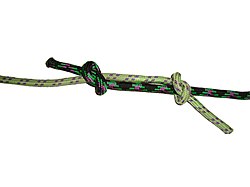m (W126jep moved page Adventist Youth Honors Answer Book/Knot/Fisherman's bend to AY Honors/Knot/Fisherman's bend without leaving a redirect: Part of translatable page "Adventist Youth Honors Answer Book/Knot/Fisherman's bend") |
|||
| (47 intermediate revisions by 5 users not shown) | |||
| Line 1: | Line 1: | ||
| − | + | <noinclude><translate><!--T:3--> | |
| − | + | </noinclude> | |
| − | < | + | {{Knot |
| − | + | | image=Noeud de pécheur déserré.jpg | |
| − | + | | name=Fisherman's knot | |
| − | </ | + | | use= |
| − | + | The '''Fisherman's knot''' is a specialized bend. It consists of two overhand knots wrapped around each other. It works well for joining thin, stiff, or slippery lines. | |
| − | + | It requires little dexterity to tie, so is often used in stubborn materials. When tightened, it becomes fairly compact, and the free ends can be cropped very close to the knot. These qualities make it very useful for fishing line--it is less likely to jam a fishing rod than many other bends, and is easier to tie with cold, wet hands. | |
| − | ''' | + | |tying_instructions= |
| − | ''' | + | To tie the fisherman's knot, lay the two ends to be tied alongside each other and facing opposite ways. Tie an overhand knot on the first rope and pass the second rope through the loop formed. Tighten the overhand knot, to prevent the line inside it from flopping around. Then tie another overhand knot on the second rope with the first rope passing through it. |
| − | + | }} | |
| − | + | <noinclude></translate></noinclude> | |
| − | + | {{#ifeq:{{#titleparts:{{PAGENAME}}|1}}|Adventist Youth Honors Answer Book|[[Category:Adventist Youth Honors Answer Book|{{SUBPAGENAME}}]]}} | |
| − | |||
| − | |||
| − | |||
| − | |||
| − | |||
| − | |||
| − | |||
| − | ' | ||
| − | |||
| − | |||
| − | |||
| − | |||
| − | |||
| − | |||
| − | |||
Latest revision as of 14:14, 8 September 2021
| Fisherman's knot |
|---|
|
Use: The Fisherman's knot is a specialized bend. It consists of two overhand knots wrapped around each other. It works well for joining thin, stiff, or slippery lines.
It requires little dexterity to tie, so is often used in stubborn materials. When tightened, it becomes fairly compact, and the free ends can be cropped very close to the knot. These qualities make it very useful for fishing line--it is less likely to jam a fishing rod than many other bends, and is easier to tie with cold, wet hands.
How to tie:
|

